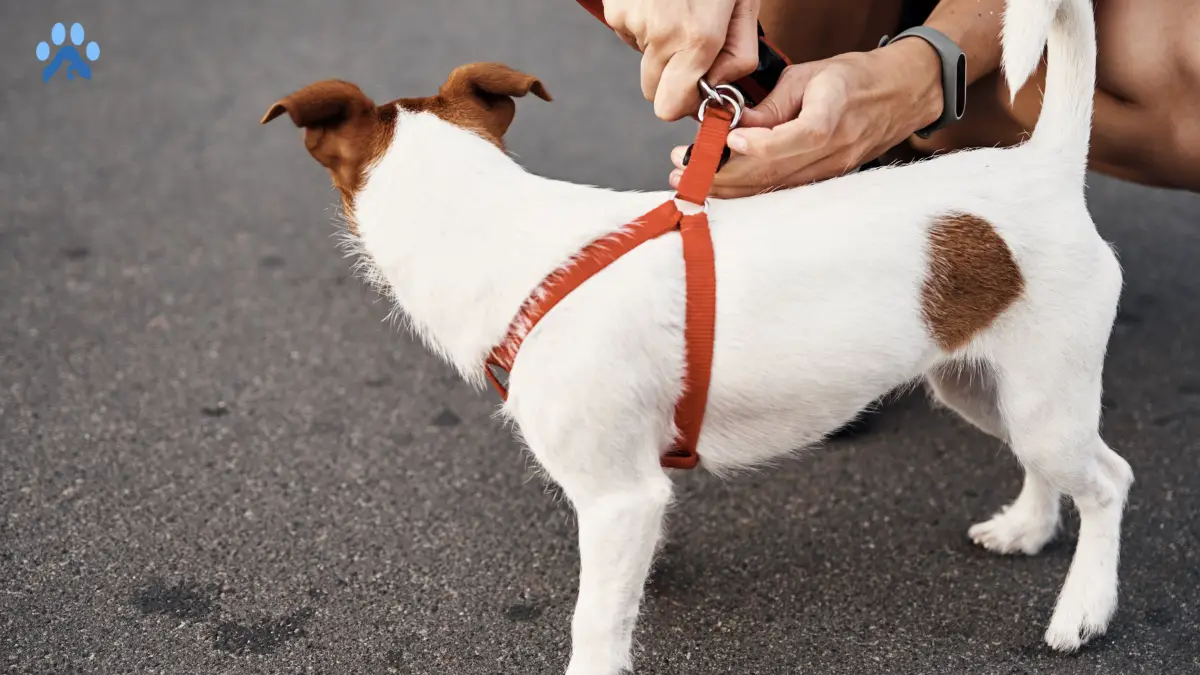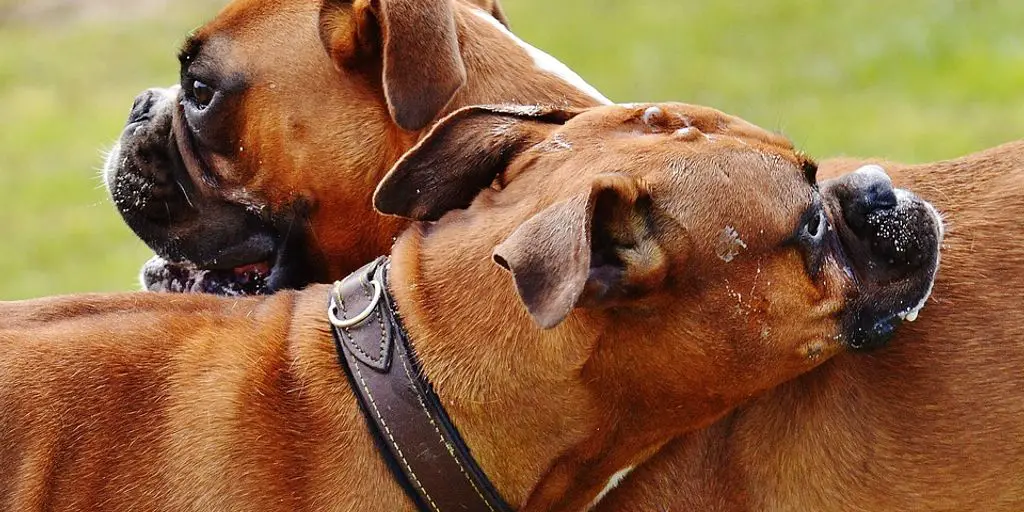Putting a harness on your dog can be a daunting task, especially if you’re new to dog ownership. However, with the right tools and techniques, it can be a simple and stress-free process. A well-fitted harness can provide comfort and safety for your pet, while also giving you better control during walks.
There are several types of harnesses available, including vest, step-in, and overhead designs. It’s important to choose the right one for your dog’s size, breed, and age. A properly fitted harness should be snug but not too tight, with enough room for your dog to move comfortably. When putting on the harness, it’s important to position it in the right place on your dog’s body to avoid any discomfort or pressure points.
To put on the harness, start by laying it flat on the ground and positioning your dog’s front feet in the loops. Then, bring the harness up and around your dog’s shoulders, making sure the buckles are on top of the D-rings. Finally, clip the harness together on your dog’s back and adjust the straps for a secure fit. With a little patience and practice, you and your pet can enjoy a comfortable and safe walking experience.
Types of Dog Harnesses
When it comes to choosing a dog harness, there are many types available on the market. Each type of harness has its own unique features and benefits. Here are some of the most common types of dog harnesses:
Step-In Harness
A step-in harness is a type of harness that your dog steps into and then you fasten it around their body. This type of harness is great for dogs who don’t like things going over their head. It’s also easy to put on and take off. Step-in harnesses come in different sizes, so make sure to measure your dog’s chest to find the right size.
Overhead Harness
An overhead harness is a type of harness that you place over your dog’s head and then fasten it around its body. This type of harness is great for dogs who are escape artists because it’s harder for them to wiggle out of. Overhead harnesses come in different sizes, so make sure to measure your dog’s neck and chest to find the right size.
Standard Harness
A standard harness is a type of harness that goes around your dog’s body and has two straps that go over their shoulders. This type of harness is great for dogs who pull on their leash because it distributes the pressure evenly across their body. Standard harnesses come in different sizes, so make sure to measure your dog’s chest to find the right size.
Front-Clip Harness
A front-clip harness is a type of harness that has a leash attachment in the center of your dog’s chest. This type of harness is great for dogs who pull on their leash because it helps to discourage pulling. Front-clip harnesses come in different sizes, so make sure to measure your dog’s chest to find the right size.
No matter what type of harness you choose, make sure it fits your dog properly. A harness that is too loose can slip off, while a harness that is too tight can be uncomfortable for your dog. Measure your dog’s chest, neck, and body to find the right size harness for them.
Choosing the Right Harness
When it comes to choosing the right harness for your dog, there are several factors to consider to ensure the comfort, safety, and effectiveness of the harness.
Size and Fit
The first thing to consider is the size and fit of the harness. A harness that is too tight can be uncomfortable for your dog, while a harness that is too loose can be unsafe and allow your dog to slip out of it. Measure your dog’s chest and neck to determine the ideal size, and refer to sizing guidelines provided by the manufacturer. Look for adjustable straps to ensure a snug and secure fit.
Design and Comfort
The design and comfort of the harness are also important factors to consider. Look for a harness with padding to prevent rubbing and chafing, and a wider chest strap to distribute pressure evenly. The harness should be positioned higher up on the shoulders and back, rather than on the neck, to prevent choking and discomfort. A front-clip dog harness can also be a good option for dogs that pull, as it can help discourage pulling and provide better control.
Safety and Security
The safety and security of the harness are crucial to ensure your dog’s well-being. Look for a harness with sturdy clips and D-rings that are positioned correctly to prevent twisting and tangling. The belly strap should be positioned behind the ribcage to prevent choking, and the harness should be stable and not shift around while walking. A vest harness can also be a good option for added stability and security.
Training and Age
Consider your dog’s training and age when choosing a harness. A puppy may require a smaller and more lightweight harness, while an older dog may benefit from a harness with more support and padding. A dog that is not yet trained to walk on a leash may benefit from a standard harness with a back clip, while a trained dog may do better with a front-clip harness.
In conclusion, choosing the right harness for your dog is an important decision that can impact their comfort, safety, and overall well-being. By considering factors such as size and fit, design and comfort, safety and security, and training and age, you can find the ideal harness for your furry friend.
Putting on the Harness
Putting on a harness on your dog can be a daunting task, especially if you have never done it before. However, with the right instructions and a bit of patience, it can be an easy and stress-free experience for both you and your furry friend.
Step-by-Step Instructions
- Choose the Right Harness: Before you begin, make sure you have the right size and type of harness for your dog. There are different types of harnesses available, such as standard harnesses, front-clip harnesses, and back-clip harnesses. Also, ensure that the harness is not too tight or too loose, and it should fit comfortably around your dog’s ribs.
- Get Your Dog to Stand: Ask your dog to stand still and calm. It is easier to put on the harness when your dog is standing rather than sitting or lying down.
- Place the Harness Over Your Dog’s Head: Slip the harness over your dog’s head, with the D-ring facing up on your dog’s back. If your harness has a front clip, the D-ring will be on your dog’s chest.
- Adjust the Harness: Adjust the harness to fit your dog’s body by pulling the straps and buckles. Ensure that the harness is snug but not too tight around your dog’s armpits. Check that you can fit two fingers between the harness and your dog’s body.
- Clip the Harness: Once you have adjusted the harness, clip the buckles together. If your harness has a back clip, the buckle will be on your dog’s back. If your harness has a front clip, the buckle will be on your dog’s chest.
- Check the Fit: Check the fit of the harness again by running your fingers along the straps and buckles. Ensure that the harness is not too tight or too loose. Also, check that your dog can move comfortably and breathe properly.
Tips and Tricks
- If your dog is not comfortable with the harness, try getting them used to it by letting them wear it around the house for short periods.
- Use positive reinforcement to help your dog associate the harness with something positive, such as treats or praise.
- If you have a wriggly dog, try putting the harness on while they are in a squatting position.
- If you have an extra small or extra large dog, ensure that you choose a harness that fits them properly.
- Be careful not to pinch your dog’s skin or fur when adjusting the harness.
By following these step-by-step instructions and tips, you can easily put a harness on your dog without any stress or discomfort. Remember to choose the right harness and adjust it properly to ensure your dog’s safety and comfort.
Adjusting the Harness
Adjusting the harness is crucial to ensure that your dog is comfortable, safe, and secure during walks. Here are some guidelines to follow when adjusting your dog’s harness:
Fit and Size
The harness should fit snugly but not be too tight or too loose. A properly fitted harness should allow you to fit two fingers between the harness and your dog’s body. It’s important to choose the right size harness for your dog, as a too-small harness can be uncomfortable and a too-large harness can slip off.
Positioning
The harness should be positioned on your dog’s shoulders and not on its neck. This will prevent pressure on their throat and reduce the risk of choking or injury. The belly strap should sit comfortably behind your dog’s front legs.
Straps and Buckles
Make sure that all straps are adjusted to the same length and that the buckles are securely fastened. Check that the D-rings are positioned correctly for attaching the leash.
Front-Clip Harness
If you are using a front-clip harness, the leash should be attached to the front D-ring. This will give you more control over your dog’s pulling and make walks more comfortable for both you and your dog.
Loop and Leg Hole
If your harness has a loop or leg hole, make sure that it is adjusted to the right size for your dog’s paw. This will prevent discomfort and slipping.
Padding and Design
Look for a harness with padding to provide extra comfort for your dog. A wider harness will also be more stable and prevent twisting. Choose a harness with an adjustable design to ensure the ideal fit for your dog’s body shape.
Training
If your dog is not used to wearing a harness, it’s important to introduce it gradually. Let your dog sniff the harness and reward them with treats for positive behavior. You can also kneel down to your dog’s level to make them more comfortable.
By following these guidelines, you can ensure that your dog’s harness is adjusted properly for a safe and comfortable walk. Remember to check the fit regularly, especially for growing puppies or dogs of different ages. If you have any concerns about adjusting the harness, consult a professional trainer for advice.
Frequently Asked Questions
How do you adjust a dog harness?
Adjusting a dog harness is important to ensure a comfortable and secure fit for your furry friend. First, loosen all the straps and place the harness over your dog’s head. Then, adjust the straps around your dog’s chest and belly, making sure they are snug but not too tight. Finally, adjust the straps around your dog’s neck, ensuring that they are not too loose or too tight. Always check the fit of the harness regularly to ensure it remains secure and comfortable for your dog.
What are the different types of harnesses for dogs?
There are several types of harnesses for dogs, including back-clip, front-clip, and no-pull harnesses. Back-clip harnesses are the most common and feature a clip on the back of the harness for attaching a leash. Front-clip harnesses have a clip on the front of the harness, which can help prevent pulling. No-pull harnesses are designed to discourage pulling by adding pressure when the dog pulls.
How do you choose the right size harness for your dog?
To choose the right size harness for your dog, measure your dog’s chest and neck circumference. The harness should fit snugly but not be too tight or too loose. Always check the sizing chart provided by the manufacturer to ensure that you select the correct size.
Can you use a harness for training a dog?
Yes, harnesses can be used for training dogs. No-pull harnesses, in particular, are designed to help discourage pulling and can be helpful during training. However, it’s important to note that a harness should not be used as a substitute for proper training and behavior modification.
What are the benefits of using a harness instead of a collar?
Using a harness instead of a collar can be beneficial for several reasons. Harnesses can help prevent choking and other injuries that can occur when a dog pulls on a leash. They also provide more control and can be helpful for dogs with respiratory problems or neck injuries. Additionally, harnesses can help prevent escape and are less likely to cause damage to your dog’s fur or skin.
How do you properly fit a harness on a dog?
To properly fit a harness on a dog, follow the manufacturer’s instructions and adjust the straps to ensure a snug but comfortable fit. It’s important to check the fit of the harness regularly, especially if your dog is still growing or gaining, or losing weight. Always ensure that the harness is not too tight or too loose and that it does not rub or chafe your dog’s skin.



